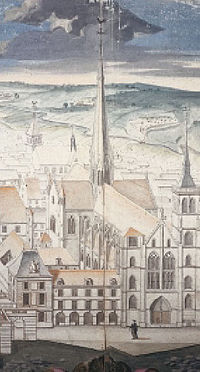Sainte-Chapelle (Dijon)

The Sainte-Chapelle de Dijon in the Ducal Palace of Dijon was the private chapel of the Dukes of Burgundy and the seat of the Order of the Golden Fleece until the death of Charles the Bold in 1477 and the relocation of the order to the Coudenberg Palace in Brussels . From 1802 the chapel was demolished.
The origins
Duke Hugo III. set out on a pilgrimage to the Holy Land in 1171 . When his ship got caught in a storm on the crossing, he vowed to build a church in the area of his residence in Dijon, which he would consecrate to the Virgin Mary and John the Baptist. After he had given the appropriate land to the Holy See , on his return in 1172 he founded a college of ten canons , which he endowed with significant privileges. The number was increased to 20 in 1214 and finally to 24 plus the doyen .
The Order of the Golden Fleece
After the establishment of the Order of the Golden Fleece in 1430, Duke Philip the Good designated the Sainte-Chapelle in 1432 as "lieu, chapitre et collège", i.e. the seat of the order. Due to the military conflicts of the time, the order could only meet for its third chapter on November 30, 1433 in the Sainte-Chapelle.
The miraculous host
The “miraculous host” ( l'hostie miraculeuse ), which Philip the Good received from Pope Eugene IV on September 27, 1434 as thanks for his support at the Council of Basel , was kept in a monstrance in the Sainte-Chapelle .
The Sainte-Chapelle from the 15th to 18th centuries
- After entering Dijon on July 31, 1479, the French King Louis XI. in August the Sainte-Chapelle under his protection.
- On May 12, 1484 a brotherhood was founded that cultivated the host.
- On May 21, 1505, King Ludwig XII. after the convalescence from an illness of the Sainte-Chapelle, the crown that he had worn at his coronation in Reims to attach it to the monstrance with the Holy Host.
- On July 22nd, 1556, due to a six-month drought, a procession with the Holy Host was held.
- On July 27, 1631, a procession was held to fight the plague that raged in Dijon. The same thing was repeated in 1637.
- Louis II. De Bourbon, prince de Condé presented the Sainte-Chapelle with the flags that he captured on June 25, 1643 in the battle of Rocroi .
The destruction of the Sainte-Chapelle
During the Revolution , the Sainte-Chapelle was left to looters. On January 8, 1791, the Holy Host was brought to St. Michel's Church (and destroyed on February 10, 1794). Graves were desecrated on February 25, 1792, and bells were broken on May 18. On May 23, the wooden choir stalls were brought to the Church of St. Bénigne. On June 7th the floor was destroyed, on June 11th the grilles and statues were removed, on June 30th the organs were dismantled to install them in the church of St. Michel. Subsequently, the Sainte-Chapelle served as a prison for some time. The roof truss mountings and some glass windows were stolen. The decay of the structure led to the demolition order in 1801. The building was auctioned for 38,000 francs and demolition began in 1802 and lasted until 1804.
literature
- Françoise de Gruben, Les chapitres de la Toison d'or à l'époque bourguignonne (1430–1477), Louvain, Leuven University Press, 1997, 613 pages ( ISBN 9061867460 )
- Pierre Quarré, La Sainte Chapelle de Dijon: Siège de l'Ordre de la Toison d'or, Dijon, Musée des beaux-arts de Dijon, 1962, 56 pp.
- Sophie Jugie, La Sainte-Chapelle du Palais des Ducs de Bourgogne, Musée des beaux-arts de Dijon, 2002
Remarks
- ↑ Quarré, p. 7
- ↑ Gruben, p. 67
- ↑ Jugie
- ↑ Gruben, p. 85
- ↑ Ordonnances of roys de France de la troisième race ... Volume 18, 1828. P. 497
- ^ Lettres de Saint François de Salles, Volume 1, Paris, 1758, p. 584
- ^ A b Lettres de Saint François de Salles, Volume 1, Paris, 1758, p. 586
- ↑ Lettres de Saint François de Salles, Volume 1, Paris, 1758, pp. 586-587
- ^ Mairie de Dijon: Dossier 2M1, notes and manuscript Baudots in the Bibliothèque municipale de Dijon
Coordinates: 47 ° 19 ′ 18 " N , 5 ° 2 ′ 33" E
